Quaker parrots, also known as monk parakeets, are an intelligent and social bird species popular as pets due to their charming personalities and ability to mimic human speech. Training a Quaker parrot requires patience, consistency, and an understanding of their smart and inquisitive nature. Owners can build a strong foundation of trust and companionship with their Quaker parrots through effective training techniques.
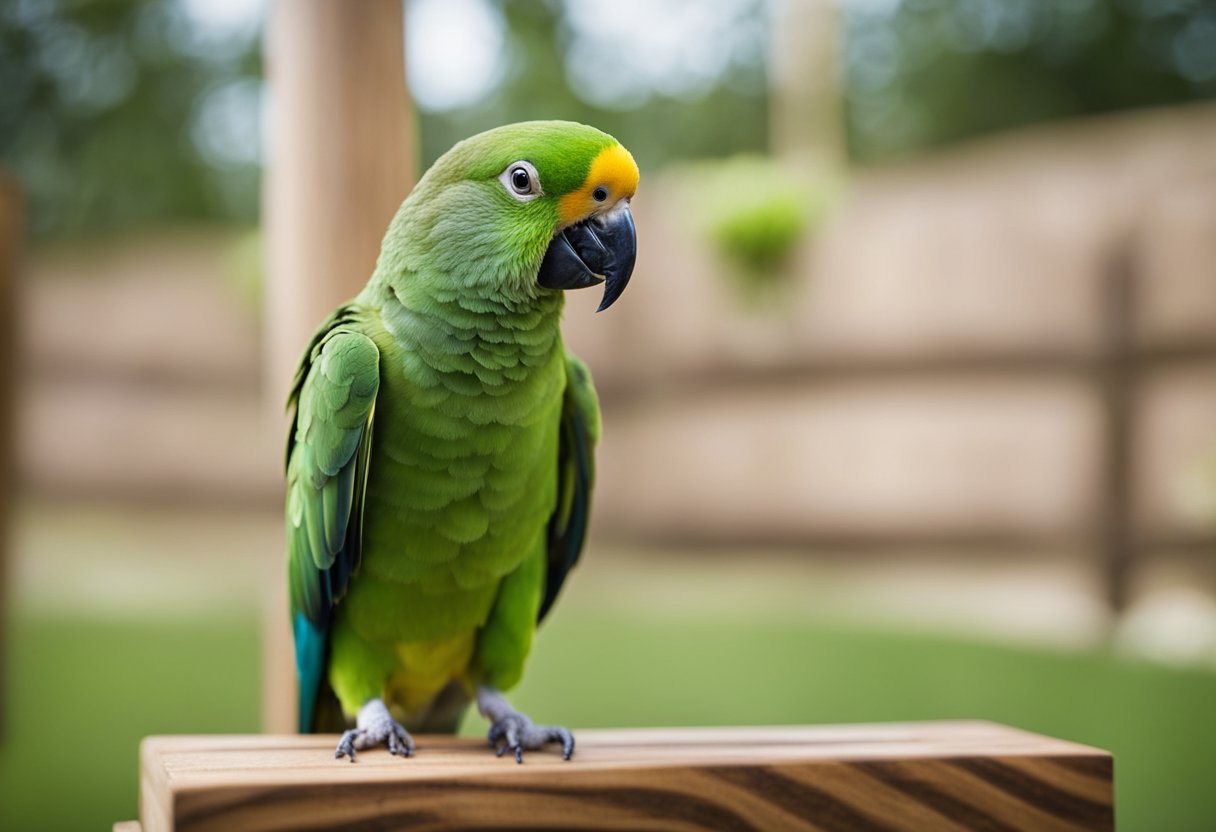
As social creatures, Quaker parrots thrive on interaction and engagement with their owners. Establishing a regular training routine not only enhances their cognitive abilities but also reinforces their social bonds. Starting with basic commands and gradually introducing more complex tasks allows these birds to learn at a comfortable pace while preventing boredom and encouraging mental stimulation.
Effective Quaker parrot training relies on positive reinforcement principles. Offering praises, treats, and affection when they successfully perform a desired behavior motivates them to repeat the action. This approach promotes a positive learning environment, making training sessions enjoyable for both the parrot and the owner.
Understanding Quaker Parrots
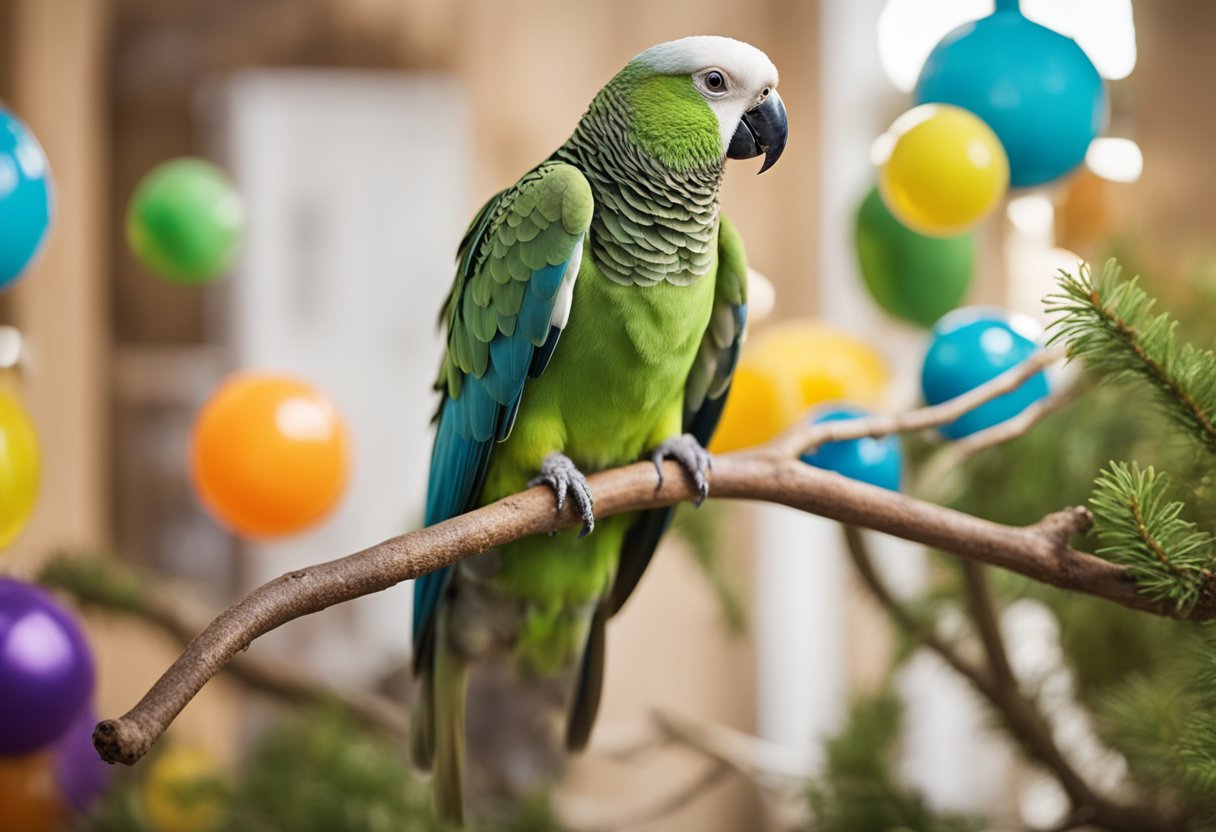
Quaker Parrots, also known as Monk Parakeets, are intelligent and social pet birds that hail from South America. Recognizing their distinctive traits and needs is key for successful training and care.
Species Origins and Habitat
Quaker Parrots originate from the temperate regions of Argentina and the surrounding countries in South America. Adapted to various habitats, these birds can thrive in both wild and urban areas, often building large, communal nests. Notably versatile, Monk Parakeets have established feral populations in many parts of the world.
Physical Characteristics and Varieties
Adult Quaker Parrots typically exhibit a bright green plumage, with grayish breasts and blue flight feathers, and average in size from 11 to 12 inches (28 to 30 centimeters) in length. However, breeding efforts have also produced a variety of color mutations, including albino and pied variants. Regardless of color, they are easily recognized by their monk-like facial feathering pattern.
Behavioral Traits
As social beings, Quaker Parrots display a range of behaviors from charming vocalizations, with some individuals capable of mimicking human speech, to territorial behavior. These birds can be quite possessive over their space and toys. Understanding their social and aggressive tendencies is crucial for appropriate training and socialization.
Dietary Needs and Health
A balanced diet is vital for Quaker Parrots, consisting primarily of high-quality seeds, pellets, and fresh water. Additionally, a variety of vegetables, fruits, and nuts should be included to provide essential nutrients. Caution in diet control is advisable to prevent obesity, which is a common health problem in captive birds.
Common Health Issues
Quaker Parrots are susceptible to a few health issues, including feather plucking, a potential sign of nutritional deficiencies or psychological distress. Biting behavior may emerge if they are not properly trained and handled. Regular veterinary check-ups are encouraged to monitor and maintain their health and well-being.
Foundations of Quaker Parrot Training
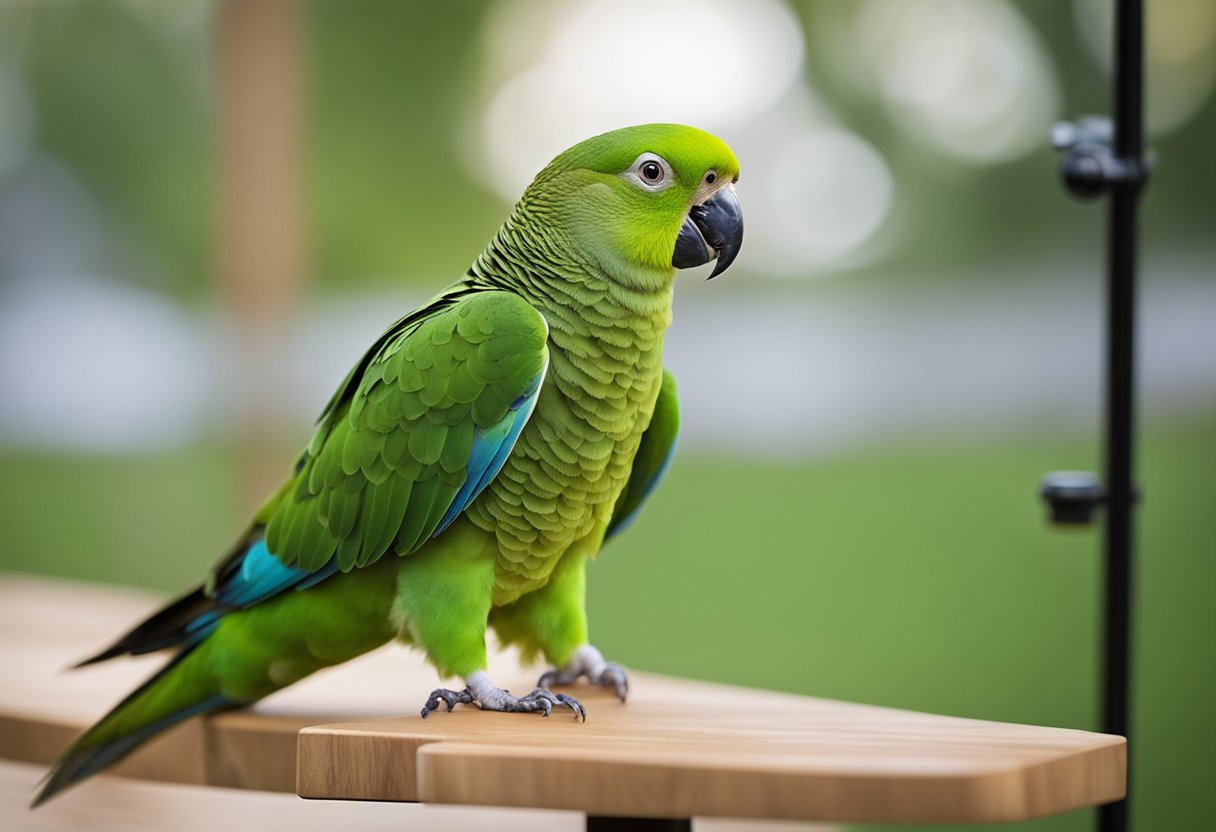
Training a Quaker Parrot requires an understanding of their specific needs and behaviors. Success hinges on establishing trust, providing proper socialization, and creating an engaging habitat.
Building Trust and Bonding
One initiates training by nurturing a bond to establish trust. Patience is critical, as trust-building takes time. Interactions should be gentle and consistent, involving activities like speaking softly to the bird, offering treats from the hand, and allowing the bird to come and go from its cage on its own terms. Cuddling and petting are encouraged once the parrot is comfortable, as they strengthen the bond.
Importance of Socialization
Socialization is a cornerstone of a well-adjusted Quaker parrot. They are social beings requiring interaction for their mental well-being. Introduce the parrot to various people and safe environments. Consistent communication is key to training and should include verbal cues and body language, which facilitates a deeper understanding between the owner and the bird, enhancing the training process.
Creating a Stimulating Environment
An enriched environment is vital for a Quaker parrot’s cognitive development. Their cage should be spacious with various toys for mental and physical exercise. Incorporate puzzle toys to challenge the bird and provide rewards when solved. Exercise is also essential, so ensure the bird has room to fly and explore. Regular access to a play area stocked with assorted toys encourages agility and intellectual stimulation.
Basic Training Techniques
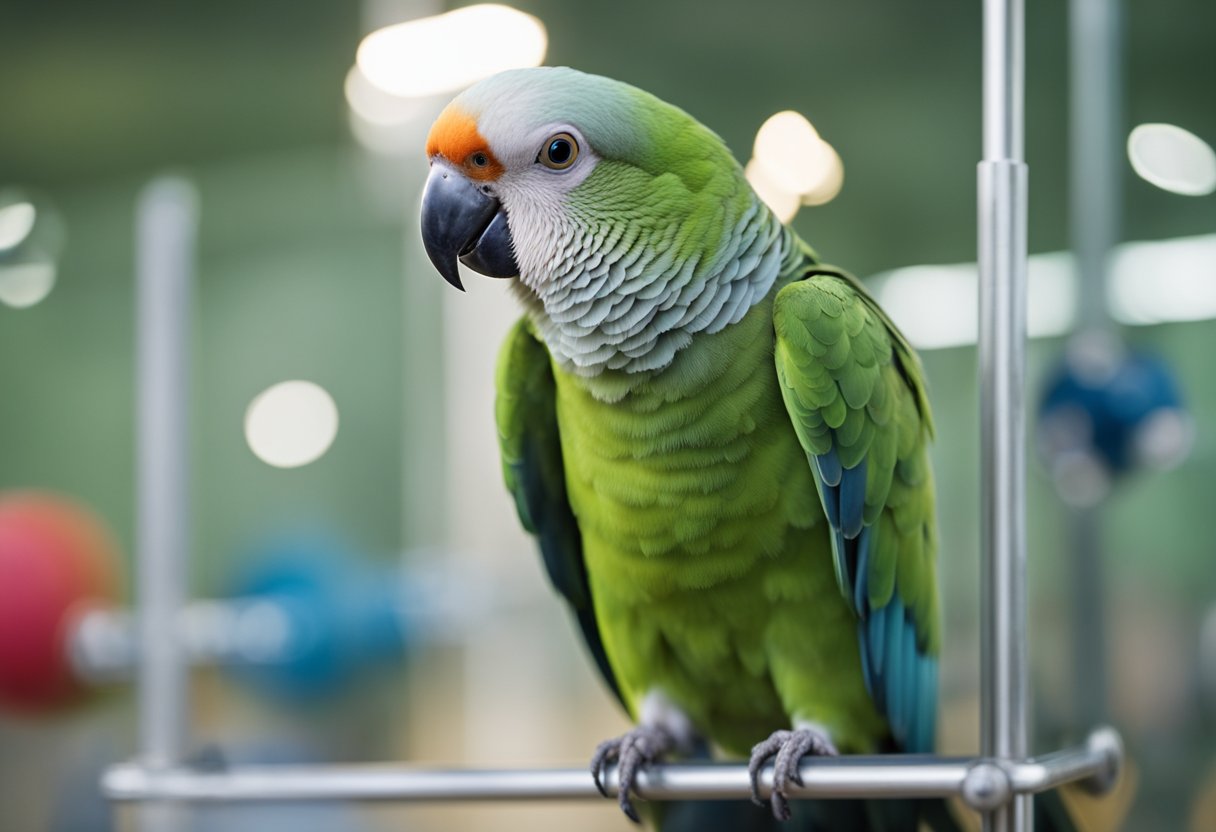
When training Quaker parrots, employing positive reinforcement and rewards, coupled with patience and consistency, is crucial for teaching them basic commands and behaviors.
Stick Training and Stepping Up
Stick training provides a safe and effective method to teach Quaker parrots to step up onto a stick or perch before progressing to the finger. By holding the stick near the parrot and using a consistent command word, such as “up,” they learn to associate the stick with the command. Offering treats or verbal praise as rewards immediately after the desired action reinforces this behavior.
Target Training and Recall
Target training involves teaching the Quaker parrot to touch a target, like a stick or a finger, with its beak. When the parrot achieves this, they should be rewarded with treats to reinforce the behavior. Recall training builds on this by teaching the parrot to come when called, using a specific command, such as “come,” paired with positive reinforcement. This technique not only enhances the bond between owner and parrot but also ensures the bird’s safety in various environments.
Training for Handling and Cuddling
Gradual conditioning allows a Quaker parrot to become comfortable with handling, leading to cuddling over time. It’s important to move slowly, respecting the parrot’s comfort level, and to reward good behavior liberally with treats or affection. Starting by offering a finger for the parrot to step onto when they appear calm and willing, and progressing when they are ready, ensures a positive experience for both the parrot and the trainer.
Advancing Training Skills
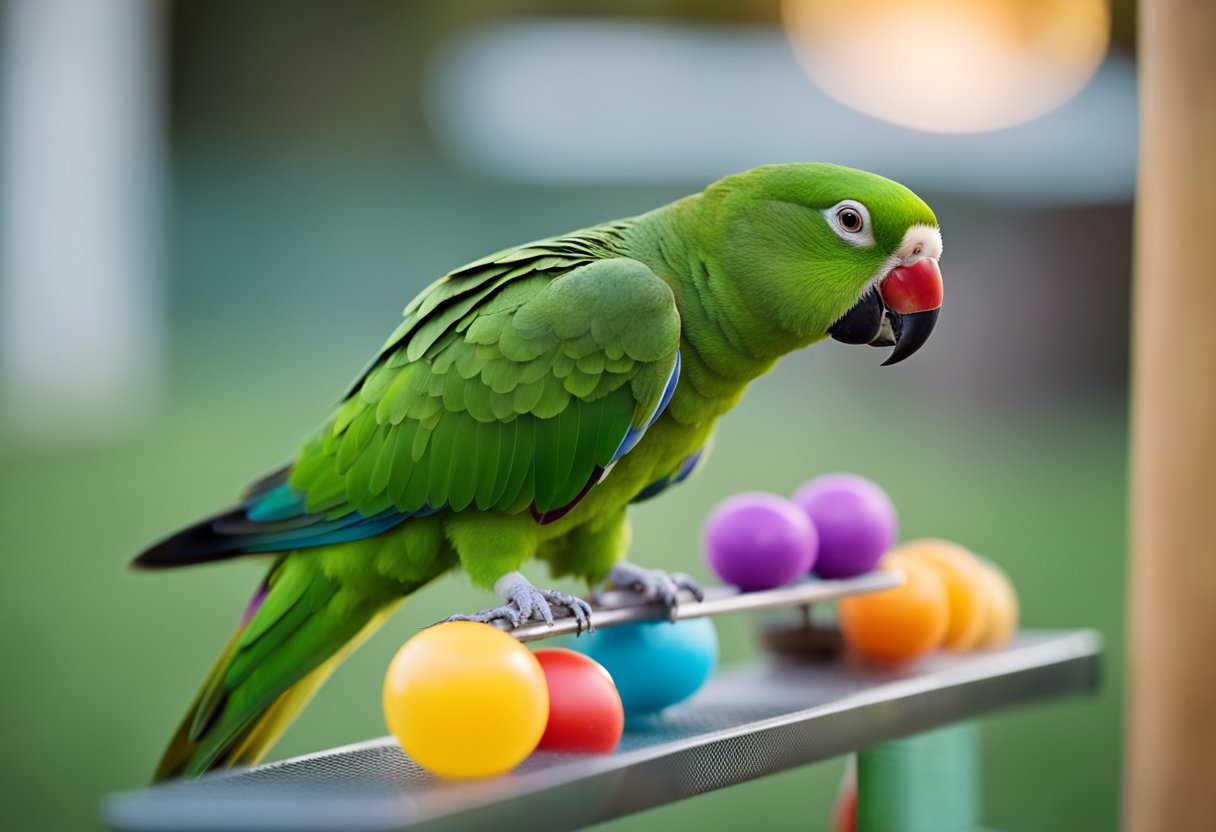
When advancing the training skills of a Quaker Parrot, consistency and increasingly complex challenges are essential. Owners should build on the bird’s natural intelligence and eagerness to learn with focused training techniques.
Finger Hop Training
To master finger hop training, start by holding one finger near the Quaker Parrot — close enough for the bird to feel comfortable stepping onto it. Command the bird to ‘hop’ onto the finger and reward successful behavior with treats. This process should be repeated multiple times to reinforce the behavior through repetition. Gradually increase the distance between the fingers to encourage the bird to hop further. Dedication to daily practice sessions will result in consistent performance in this trick.
Teaching Speech and Mimicry
Parrots are renowned for their ability to mimic human speech and sounds. When teaching a Quaker Parrot words, sentences, or rhymes, speak clearly and repeat the phrase in the same tone each time. Utilize a table to track the progress and complexity of words or sounds learned:
| Session | Words/Phrases Introduced | Response Level |
|---|---|---|
| 1 | Hello, Bye, Good | Initial recognition |
| 2 | Hello, Bye, Good | Clear repetition |
| 3 | What’s up, Laugh, Sing | Mimicking |
Pair each word or phrase with a specific command and reward. For instance, offer praise or a treat when the parrot successfully mimics the word ‘hello’ after the command. Inject variety into the sessions by including singing and mimicking different sounds. The Quaker Parrot’s intelligent nature makes it capable of learning a diverse vocabulary with time and patience.
Behavioral Correction
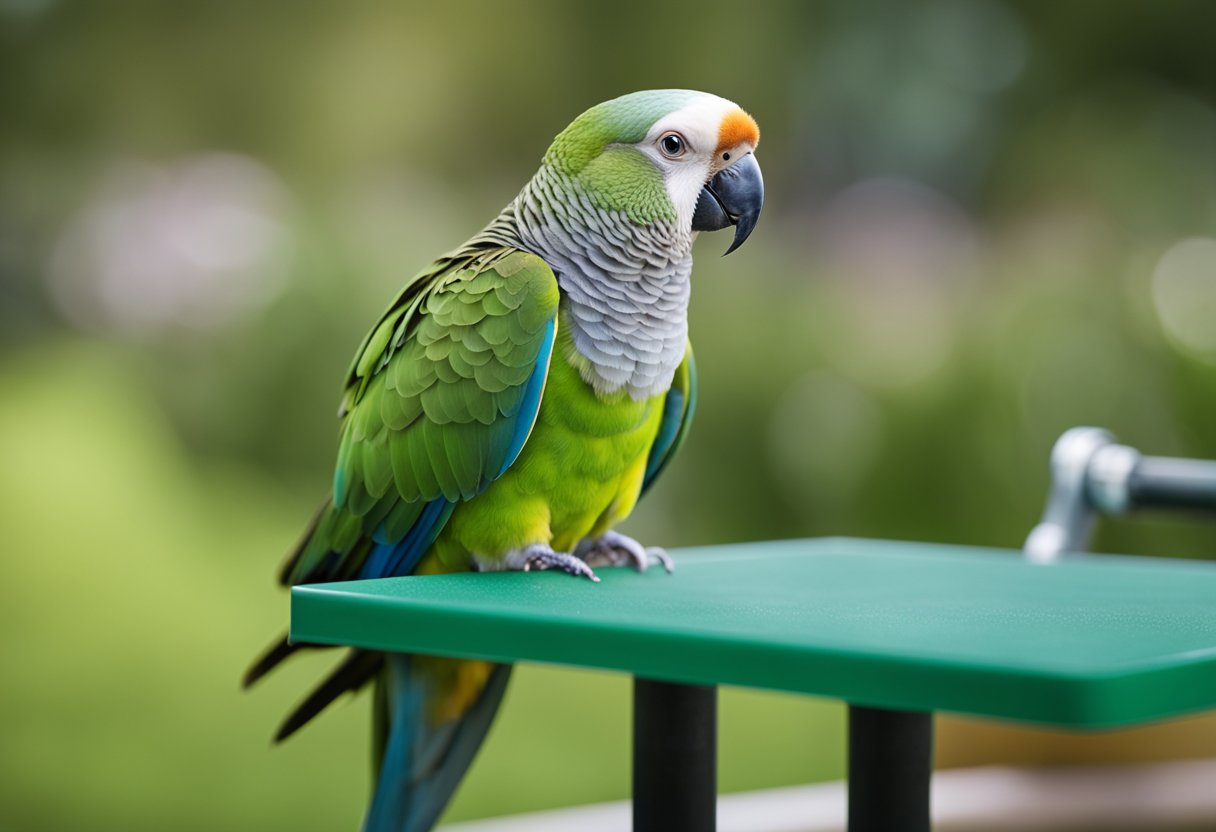
Effective behavioral correction in Quaker Parrots hinges on consistency and positive reinforcement. This approach builds trust and encourages the desired behavior without resorting to punishment.
Addressing Aggressive Behaviors
When a Quaker Parrot exhibits aggressive behavior, it’s crucial to understand the cause. They may become aggressive due to fear, territorial instincts, or lack of socialization. Trainers should strive for consistency in their response to aggression. Instead of punishment, they can redirect the behavior using positive reinforcement techniques.
- Identify Triggers: Keep track of what provokes aggression; it could be a particular object, person, or situation.
- Positive Interactions: Gradually expose the parrot to the trigger in a controlled manner while maintaining a calm environment.
- Rewards: Offer a treat or affection when the bird remains calm in the presence of their trigger.
Curbing Unwanted Habits
Unwanted habits such as screaming or biting require persistent and patient training to modify.
- Ignore Bad Behavior: Avoid giving attention to the Quaker Parrot when it engages in the bad habit, as this can inadvertently reinforce the behavior.
- Positive Reinforcement: Reward good behavior immediately with treats or praise to reinforce the desired action.
- Routine: Establish and adhere to a daily routine to provide structure, which can reduce anxiety-related behaviors.
By employing these techniques, undesirable behaviors can be gradually corrected, leading to a happier bird and a more harmonious relationship with its handler.
General Care and Maintenance
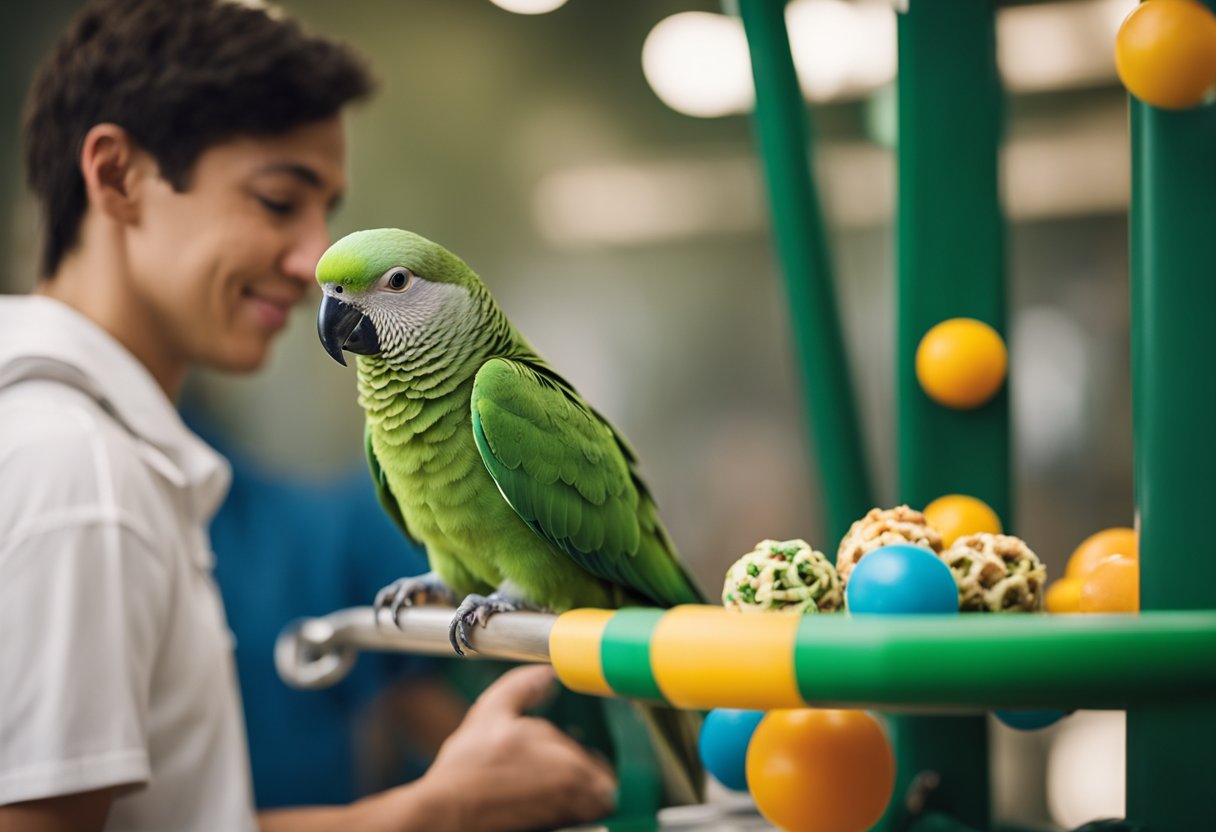
Proper cage maintenance and nutrition are crucial to the well-being of Quaker Parrots. They require consistent attention and care to ensure their safety and to foster a well-trained and healthy bird.
Cage Cleaning and Setup
Cage Cleaning
- Weekly cleaning of the cage with mild soap and water ensures hygiene. Remove and replace soiled paper or liner at the bottom of the cage.
- Wipe down surfaces and clean perches and toys to prevent the buildup of droppings and food debris.
Cage Setup
- The cage should be spacious, allowing the Quaker Parrot ample room to move, with horizontal bars for climbing.
- Include a variety of perches of different materials and diameters for foot health.
- Position the cage in an area away from drafts, with natural light and social interaction to keep the bird stimulated and content.
Providing Proper Nutrition
Food Variety Ensure a balanced diet including:
| Food Type | Examples | Frequency |
|---|---|---|
| Pellets | Formulated parrot pellets | Daily, as a staple diet |
| Seeds | Millet, sunflower, and others | Sparingly, as treats |
| Vegetables | Carrots, broccoli, leafy greens | Daily, for essential nutrients |
| Fruits | Apples, bananas, berries | A few times per week |
Nutrient Consideration
- Provide a variety of foods to ensure a full range of nutrients, avoiding an over-reliance on seeds which can lead to malnutrition.
- Fresh water should be available at all times, replaced daily to prevent bacterial growth.
Regular attention to cage cleanliness and careful monitoring of diet will help maintain the safety, health, and happiness of a Quaker Parrot.
Quaker Parrot Lifestyle
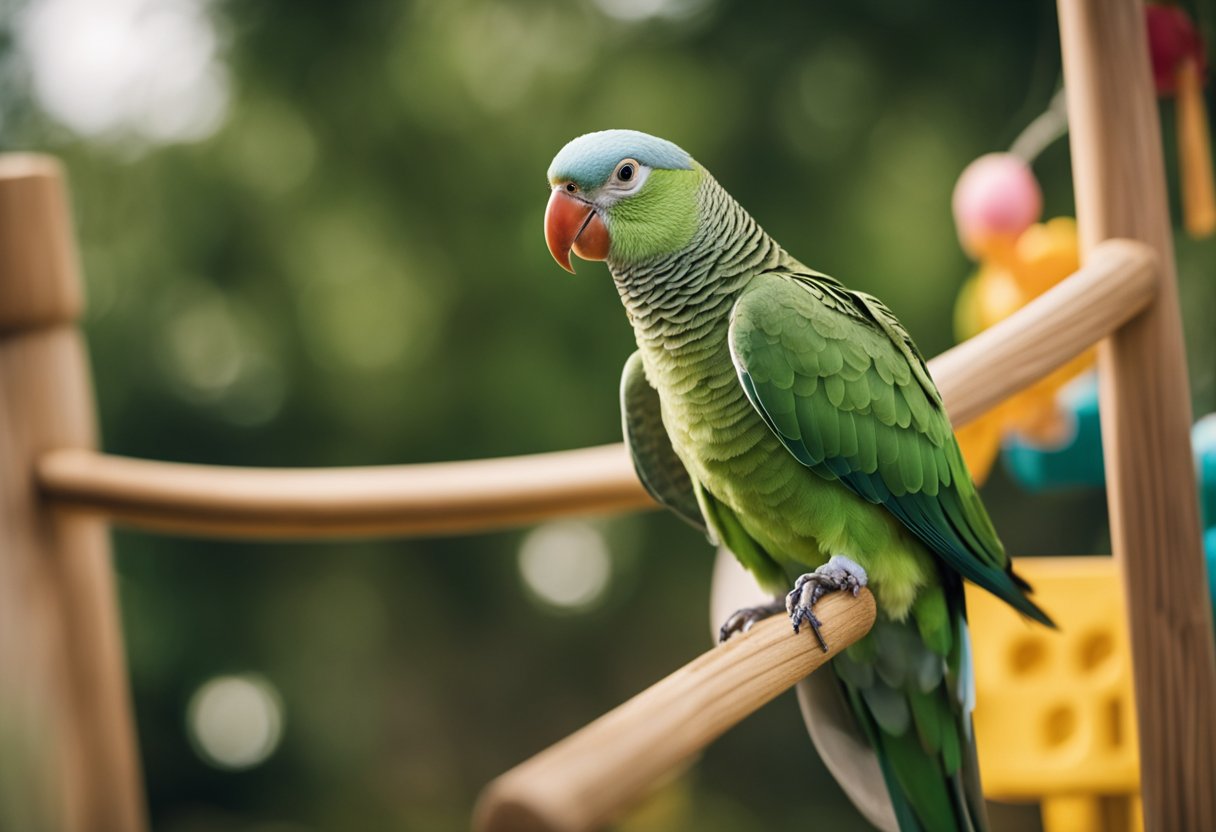
Understanding a Quaker parrot’s lifestyle requires insight into their need for companionship, daily activities, interaction with other pets, and the responsibilities of ownership.
Companionship and Lifespan
Quaker parrots exhibit social personalities and often form a strong bond with their owners. They can live for 20 to 30 years, making them lifelong pets. Regular interaction and companionship are essential to their well-being, as they thrive on social contact.
Common Activities and Exercises
These intelligent birds require mental stimulation and physical exercise. Toys and play are integral to keeping them engaged. Quaker parrots are known for their talking abilities, so exercises that encourage vocalization are particularly beneficial. They should have daily opportunities for:
- Problem-solving toys to challenge their intelligence
- Physical play for adequate exercise
Interaction with Other Pets
Quaker parrots are generally social with other pets, but introductions should be done cautiously. Different pets have unique personalities, so monitoring interactions is crucial to ensure all animals are comfortable and behave well together.
Adoption and Responsible Ownership
Adoption involves a significant commitment. Prospective owners should be prepared for a potentially 30-year relationship with their bird. Ensuring the Quaker parrot is well-behaved and social requires time, patience, and regular interaction. Before adopting, one must consider:
- Long-term commitment to the bird’s care
- Providing a nurturing environment for their lifelong pet







